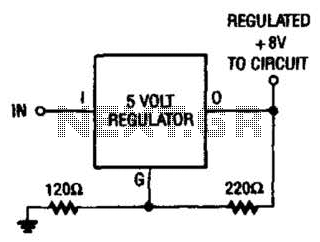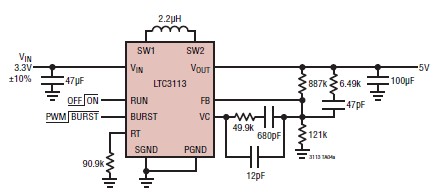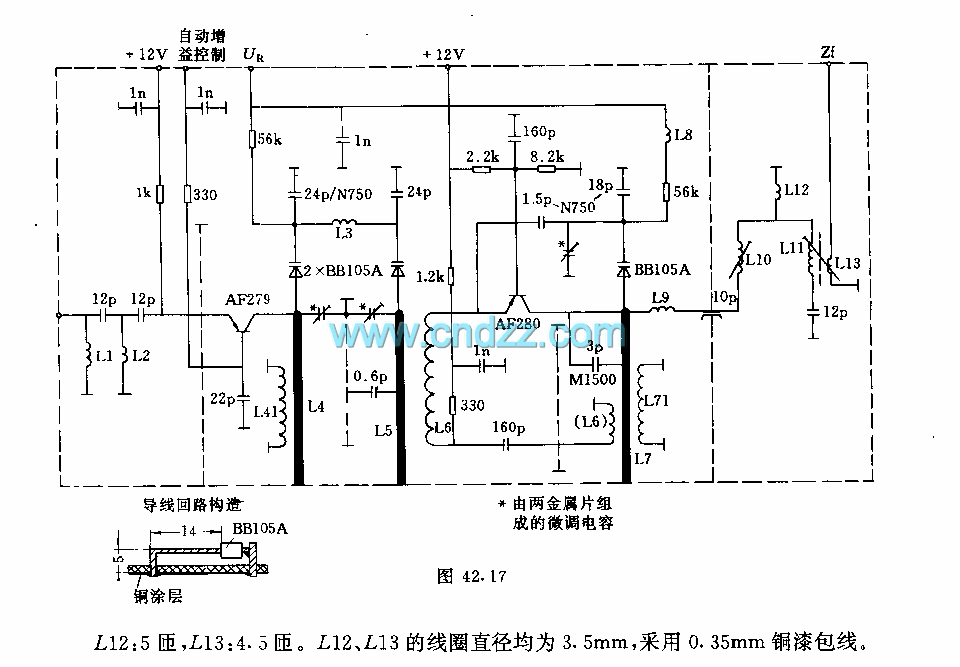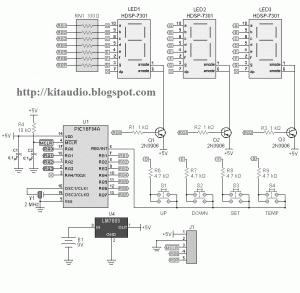
8V From 5V Regulator Circuit

If locating an 8-V regulator proves difficult, a 5-V unit can serve as a replacement by connecting the regulator as illustrated here.
In electronic circuits, voltage regulators are essential components that maintain a constant output voltage regardless of variations in input voltage or load conditions. An 8-V voltage regulator is often used in applications where a stable 8-volt supply is required. However, if this specific regulator is not readily available, a 5-V regulator can be utilized as an alternative.
To implement this substitution, the 5-V regulator must be connected in such a way that it can provide the necessary voltage level for the circuit. This typically involves ensuring that the output of the 5-V regulator is appropriately interfaced with other circuit components to achieve the desired voltage level.
In practical applications, it is important to consider the load requirements. If the load can function adequately at a lower voltage, the 5-V regulator can be directly used. However, if the circuit is designed for 8 volts, additional components such as resistors or diodes may be required to adjust the voltage levels accordingly.
The schematic for connecting a 5-V regulator in place of an 8-V regulator would include the following components: the 5-V regulator, input and output capacitors to stabilize the voltage, and possibly a diode to prevent backflow of current. The input side of the regulator would be connected to the power source, while the output would connect to the load.
It is crucial to verify the current ratings of the 5-V regulator to ensure it can handle the load requirements of the circuit. Additionally, the thermal performance of the regulator should be evaluated, as a lower voltage may result in increased heat dissipation depending on the current drawn by the load. Proper heat sinking may be necessary to prevent overheating and ensure reliable operation.
In conclusion, substituting a 5-V regulator for an 8-V regulator is feasible with careful consideration of the circuit design and load specifications. This approach allows for flexibility in component selection while maintaining operational integrity. If you have trouble locating an 8-V regulator, although they are commonly available, a 5-V unit can replace it by connecting the regulator, as is shown here.
In electronic circuits, voltage regulators are essential components that maintain a constant output voltage regardless of variations in input voltage or load conditions. An 8-V voltage regulator is often used in applications where a stable 8-volt supply is required. However, if this specific regulator is not readily available, a 5-V regulator can be utilized as an alternative.
To implement this substitution, the 5-V regulator must be connected in such a way that it can provide the necessary voltage level for the circuit. This typically involves ensuring that the output of the 5-V regulator is appropriately interfaced with other circuit components to achieve the desired voltage level.
In practical applications, it is important to consider the load requirements. If the load can function adequately at a lower voltage, the 5-V regulator can be directly used. However, if the circuit is designed for 8 volts, additional components such as resistors or diodes may be required to adjust the voltage levels accordingly.
The schematic for connecting a 5-V regulator in place of an 8-V regulator would include the following components: the 5-V regulator, input and output capacitors to stabilize the voltage, and possibly a diode to prevent backflow of current. The input side of the regulator would be connected to the power source, while the output would connect to the load.
It is crucial to verify the current ratings of the 5-V regulator to ensure it can handle the load requirements of the circuit. Additionally, the thermal performance of the regulator should be evaluated, as a lower voltage may result in increased heat dissipation depending on the current drawn by the load. Proper heat sinking may be necessary to prevent overheating and ensure reliable operation.
In conclusion, substituting a 5-V regulator for an 8-V regulator is feasible with careful consideration of the circuit design and load specifications. This approach allows for flexibility in component selection while maintaining operational integrity. If you have trouble locating an 8-V regulator, although they are commonly available, a 5-V unit can replace it by connecting the regulator, as is shown here.





